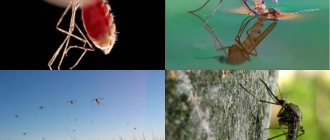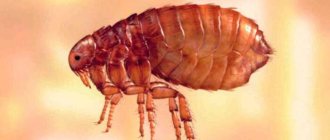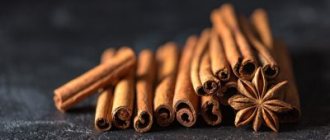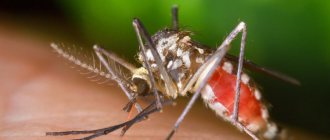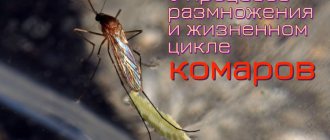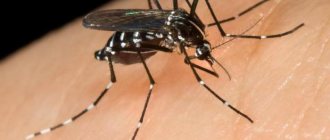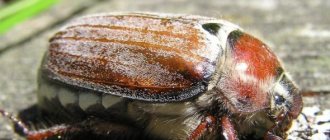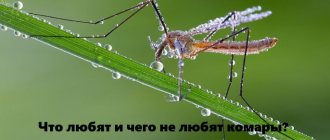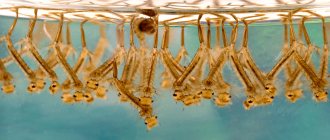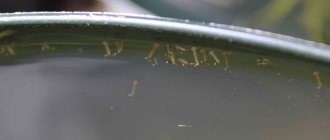Mosquitoes are considered dangerous insects, so you need to periodically control their larvae in the garden. Don't let seemingly harmless insects fool you. Although these arthropods are quite small, one bite is enough to cause serious illness.
Removing standing water is an effective strategy for eliminating mosquitoes. However, you should keep in mind that some types of mosquitoes lay eggs that can survive without water for a certain period of time. The following are effective remedies for mosquito larvae in a pond or swimming pool. You can use them too.
Mosquito larvae in a barrel of water
In stagnant waters, as well as in barrels of water used for irrigation in garden plots, various “inhabitants” are sometimes found.
Small, carnation-like insects are mosquito larvae. If there is no goal to “feed” the bloodsuckers with your own blood, measures should be taken to exterminate them. Mosquitoes remain in the larval stage for a week. Simply scooping them out of the water will not work: at the slightest danger, the larvae sink into the water column.
Popular ways to get rid of future bloodsuckers
- Cover the barrel with a lid or film. The simplest method used as prevention, i.e. preventing eggs from being laid in water. This method is not always suitable, especially in cases where the barrel is used to collect rainwater; the barrel is located in a greenhouse to increase humidity due to evaporation.
- Periodic emptying of the container. Once every 5-7 days you should completely drain the water from the container. The larvae, getting from the water onto the soil, die. The method is not suitable for large containers, or for rainy days when there is no need for watering.
- Launch the fish. The diet of some fish includes mosquito larvae. You can catch such “pets” in the nearest pond in the spring, and release the fish back into the reservoir in the fall. This method is suitable for large-capacity barrels (100-200 l).
- Use of oily liquids. Mosquito larvae are located at the surface of the water in order to breathe air. Any oily liquid can deprive them of oxygen, which will create an airtight film on the surface of the water. Suitable for use: machine oil, kerosene, gasoline.
Means for getting rid of larvae
- Natural enemies. In nature, mosquitoes feed on frogs, water spiders, swimming beetles and dragonflies. If larvae are found in a decorative pond, provide nearby shelter for natural enemies.
- Chemicals. Special chemicals are appearing on sale to combat mosquito larvae in barrels and ponds, but the water will become unsafe for humans and beneficial insects.
- Biological agents. Another modern way to prevent mosquitoes from breeding is the use of bacteria. These microorganisms poison insect larvae, leading to their death.
- Helper plants. One of the most effective ways, which does not involve financial costs and is absolutely environmentally friendly, is the use of garden plants. By periodically adding parts of repellent plants to the water, you can repel mosquitoes and prevent the appearance of new clutches of eggs. Among such plants are elderberries, horseradish leaves, garlic stems and leaves, tomato tops, and wormwood.
The appearance of mosquito larvae in filled barrels, containers and decorative ponds is a natural process due to the life cycle of the mosquito.
By getting rid of the future generation, you can significantly reduce the number of bloodsuckers in your own area, but you will not be able to completely destroy the insects: their flight range is up to 3 km.
Garlic
You've probably heard the joke that garlic cloves repel vampires. This famous story actually contains a tiny hint of truth. Did you know, for example, that garlic can help you fight mosquitoes?
Grind three to five heads of garlic using a blender. Next, wrap the crushed garlic in a cloth and squeeze it over a bowl or container to extract the juice. Mix the juice with 3 liters of water and add the solution to standing water infested with mosquito larvae.
Mosquito bite - what is the danger
The female blood-sucking mosquito has sharp jaws, with which it gnaws a hole in the skin of a person or animal, while simultaneously spraying saliva into the victim’s body with a substance that prevents blood clotting. It is this component of saliva that causes an allergic reaction in the form of itching, redness of the skin and swelling.
She then plunges her proboscis into the wound and sucks out the “red liquid.”
The female may bite several times until she receives the amount of blood and protein she needs, after which she goes in search of a moist place where she can lay eggs. Unfortunately, mosquitoes do not die like bees, but, on the contrary, multiply after being bitten.
The female is ready for fertilization immediately after she lays her eggs.
Mosquitoes are not very picky and bite everyone: sick and healthy, so an infection from one organism through the insect’s proboscis can be transmitted to another organism and infect it
True, there is one important condition for infection - the causative agent of the disease must develop in the body of the bloodsucker, and not just get there. The following diseases are predominantly transmitted:
- malaria;
- yellow fever;
- encephalitis;
- meningitis;
- Lyme disease;
- filariasis;
Fortunately, HIV and AIDS are not transmitted through the bite of this insect.
In Russia, mosquitoes transmit infectious diseases from one person or animal to another, but a “special component” of their saliva can cause an allergic reaction, which can turn into dangerous angioedema (if not stopped in time).
I have heard several times that people have died after being bitten by mosquitoes because they did not receive prompt medical attention.
Video: why a mosquito bite is dangerous
There is no need to be afraid of the warm season because of some unpleasant insects: you already know what certain mosquitoes look like, which ones are really dangerous for humans, what consequences their bite can lead to, and you can by studying a little more literature , provide first aid if necessary. No bloodsuckers should spoil either you or your loved ones’ well-deserved rest.
Why are they dangerous?
The striped mosquito is dangerous to humans only if it has previously drunk blood from an infected person. That is, mosquitoes only transmit pathogens of a dangerous disease, and are not essentially a source. According to statistics, up to 3 million people die from malaria every year. The vast majority of them live in Africa.
Not all representatives of this species can be carriers of malaria. The Anopheles mosquito poses a danger to humans only in those regions where there has been an outbreak of the disease itself. Where there are no infected people, representatives of this type of insect are completely safe.
The causative agent is Plasmodium falciparum. These are single-celled microorganisms that develop in human blood cells. There the plasmodium multiplies and devastates all their contents. Having destroyed the contents of one red blood cell, it moves to another. During the period when the pathogen is released, a person experiences an exacerbation stage and severe fever.
The malaria carrier poses the greatest danger to pregnant women and young children, since their weakened immune system will not be able to fully fight the infection.
Also, malaria mosquitoes can carry pathogens of HIV infection, anthrax and many intestinal infections.
The consequences of an attack at first are no different from the bite of an ordinary squeaking mosquito: swelling forms, itching, redness and burning are felt.
Next, the malarial plasmodium develops in the liver and from there enters the blood. Progressing in the blood cells, malaria leads to regular fevers, which are replaced by chills. Fever is characterized by periodicity. Attacks occur every 3 days, after which there is a short period of improvement. Ultimately, the blood vessels in the brain become clogged and the infected person dies.
Most often, children from 6 months to 5 years are susceptible to death. Babies have passive immunity, which is passed on to them by their mother. For pregnant women, malaria is dangerous due to premature birth, eclampsia and death.
Feeding aquarium fish
Photos can be enlarged for sale
Bloodworms have always been considered the best live food for adult fish. When purchasing this food, you must carefully inspect it. It should be red, but not scarlet. Bright red bloodworms usually do not last long. It should be elastic, move when touched and lie separately, curl into a ring.
You cannot feed dead bloodworms to fish, as they can easily be poisoned. Freshly caught fish are also not suitable for feeding fish. It is necessary to withstand it for 2-4 days to cleanse the intestines, which may contain pathogenic flora of local reservoirs. During this period, the water in which the larvae are located must be changed periodically.
Store it in a cool place at a temperature of 4-8°C, for example in the refrigerator. If you have a large amount of bloodworms that cannot be kept alive for long, you can freeze them. The best way to do this is to spread it in a thin layer on plastic film, to which it does not stick. When it freezes, break the resulting pancake into pieces, put it in a plastic box and put it in the freezer.
It is recommended to feed adult aquarium fish with bloodworms using a floating feeder with holes in the bottom, through which live bloodworms gradually crawl into the water. This does not give him the opportunity to bury himself immediately in the ground. But my fish caught buried bloodworms and even pupae that emerged before the mosquitoes appeared. I did not like the recommendations to feed small aquarium fish and grown juveniles with bloodworms cut with scissors on glass. Everything flows out of the bloodworm, only skins remain, which, in my opinion, are of no value. But this method works with the tubifex.
Return to section: “feeding fish”
Other feeds:
mothcoretradaphnia tubifexcyclopartemiaciliatesenchytraeusnematodesrotifers
How to distinguish a male from a female?
The difference between a female and a male lies in the structure of the oral organ. The lips of insects are elongated and resemble a kind of case, in which there are two pairs of jaws with long and thin teeth, similar to needles. Male mosquitoes have underdeveloped jaws. Therefore, it cannot gnaw holes in the skin and feed on blood. Thus, only females are able to feed on human blood.
These insects fly at a speed of 3.2 km/hour. When using air currents, bloodsuckers can fly up to 100 km at this speed
As for the mass of the mosquito, it is so small that when the insect gets into the web, it does not cause vibrations and does not attract the attention of the spider
Is it possible to get rid of mosquitoes using folk remedies?
Do garlic, vitamin B1 or brewer's yeast repel mosquitoes?
There are many myths floating around the Internet about natural mosquito repellents. One of these misconceptions is that vitamin B1 (thiamine chloride), garlic, brewer's yeast, if eaten, repel mosquitoes. Manufacturers promise that just one tablet will protect you for 24 hours! Tempting, isn't it? But we're sorry to say, scientists at Northern California State University don't believe these "magic pills" are effective and say several studies don't support the notion that these products are effective repellents against mosquitoes, other blood-sucking insects and ticks.
Bloodworm
Bell mosquitoes (jerks) differ from their relatives in the absence of a proboscis. They don't bite. Their oral apparatus is not developed. There are also differences in the stage of larval development. She has adapted to life in the mud.
The bell mosquito larva is red in color, has a dark head and is well known to fishermen as bloodworms. Not only fish from natural reservoirs love this living creature, but also aquarium fish. There are large and smaller bloodworms. Size does not depend on environmental conditions and good nutrition. These are the larvae of different subspecies of bell mosquitoes.
The bloodworm creates narrow tube passages at the bottom of the reservoir. It builds them from particles of silt, gluing them together with secretions of its salivary glands. There are species that make passages in the leaves and stems of underwater plants, drilling suitable holes in them. When at rest, the larvae protrude from their shelter and actively feed. Their diet includes both plant plankton and small aquatic life: daphnia, rotifers, cyclops. In times of danger, the bloodworm hides in its shelter.
Unlike other mosquito larvae, this species has adapted to live even in low-oxygen environments. It does not rise to the surface of the water to breathe. Even after turning into a pupa, the bloodworm floats up only to turn into an adult mosquito.
The mosquito larva is the second stage of the life cycle of blood-sucking pests
Scientists who study insects note the importance of this stage, since during this period there is an accumulation of useful components and substances that are necessary for further development. The duration of an individual's stay in the larval stage for a long time
Although the insect resembles a worm, it feeds and moves independently. This is what makes it particularly interesting to people and scientists.
The period of growing up is accompanied by molting and an increase in size. The network contains photographs of the larvae of the squeak mosquito. They resemble small worms or caterpillars, which can have a different structure or color. The abdomen of the bloodsucker includes 10 segments.
To see how the larva of a blood-sucking mosquito develops, it is not necessary to use literature or visit specialized sites. You can find them in containers containing old water in the summer. Small worms concentrate at the top. If you lower a stick or other object into the water, they will go deeper in order to hide. These mosquito larvae and bloodworms have a certain supply of oxygen, so they can stay at the bottom for 10-15 minutes.
The transformation of a bloodworm into a pupa of an ordinary mosquito occurs after a certain period of time. The pupae are similar to tadpoles, but their colors are different. They move quickly and sometimes jump.
Appearance of the larva and structure
When answering the question of what a mosquito larva looks like, one can describe a small worm, the body length of which usually does not exceed 1 cm. But there are some differences that are clearly noticeable upon careful examination: their thoracic region is expanded in relation to the articulated abdomen, and on a large head There are 2 black eyes.
The color of the larvae depends on the type of mosquito. In the well-known squeaker they are brown, while in the malarial one they are green.
At the end of the larval body there is a long process, obliquely located in relation to the abdomen. This is a breathing tube, at the end of which there are 2 tiny holes: through them vital oxygen enters the body.
If you approach a body of water where mosquito larvae live and sweep your hand sharply over the surface of the water, they will abruptly take off and rush deeper into the water to hide from potential danger. To do this, they are helped by so-called swimming hairs. They are collected in bunches and attached to the body of the worm. The largest of them is located on the tail segment, playing the role of a kind of motor and rudder, setting the pace of swimming and the direction of movement in the water. The entire life of a mosquito in the larval stage lasts on average 3–4 weeks. Its exact duration depends not only on the species, but also on environmental conditions, primarily water temperature. During this time, intermediate molts occur: the insect sheds its body cover - the exoskeleton - so that it can increase in size.
Mosquito larvae are characterized by intensive growth: when they first hatch from the egg, their length does not exceed only 1 mm and they are almost invisible to the naked eye. By the end of the stage, the body stretches up to 1 cm. Body weight increases even faster: according to biologists, its difference from the original can be up to 500 times. When the development of the larva ends, it transforms into a pupa with a more complex structure.
Nutrition and lifespan
The larval stage of mosquitoes lasts 3-4 weeks, its duration depends on temperature and other environmental conditions. During these days, she manages to shed several times, shedding her exoskeleton and gradually increasing in size. The permissible temperature for the normal development of mosquito larvae is in the range of +10-+35°C, while the optimal temperature is +25-+30°C.
Interesting!
Along with the length, as the larva grows, its weight also increases: according to biologists, it increases 500 times in 20-30 days.
Their main food is small living creatures and microorganisms found in the reservoir: unicellular algae, decomposing plant organic matter. To obtain food, the larva filters 1 liter of water per day, which is quite a lot for such a small living creature.
The next stage of mosquito development, the formation of the pupa, occurs after the transformation of the larva itself and is a more complex creature.
Bloodworm
Bloodworms - the name of the mosquito larva from the families Chironomidae (they are also called jerks and bells) and Tendipedidae - are perhaps the most significant in human life. These creatures are used as bait in fishing, with which you can get a rich catch, so they are actively sold in specialized stores. The bell mosquito larva is well known in the aquarium hobby and among people who keep exotic reptiles at home: it is a suitable food for their pets.
These larvae prefer to live at the bottom of reservoirs, densely overgrown with vegetation. They are benthic organisms - spending their lives in mud. This is where they find their food. But, like all species, they need oxygen, so they periodically float to the surface.
Bloodworm is the larva of the Polypedilum vanderplanki mosquito with an enviable survival rate. Scientists conducted an original experiment in collaboration with a space organization, when these creatures spent more than a year in outer space (while outside the ISS). After returning, 80% of the larvae were alive. Therefore, bloodworms are rightly called the most complex organism known to science that survives desiccation.
Bloodworms are characterized by a red color, which they acquire due to the hemoglobin content. Their way of life is also curious: with the help of a substance secreted by the salivary glands, they glue together a kind of tube-shaped house from silt. It serves as a shelter for them, so the larva sticks out of it only the front part, with which it finds food.
The life and development of mosquito larvae is quite interesting. They are beneficial by performing the function of a living water filter and serving as food for fish, which is actively used by humans. The larvae also play the role of an indicator of the cleanliness of water bodies: if it is polluted, then their population dies.
Summer is coming, which means that every person will meet his long-loved insects - mosquitoes. They bother us from early childhood and haunt us even in old age. People even have some kind of myths about these bloodsuckers (for example, that mosquitoes can “recognize” the composition of human blood and therefore bite mainly those with “young” blood), but how much do we know about them?
Benefits and harms of mosquito larvae
The development and activity of mosquito larvae are not only interesting and original, but also benefit fresh water bodies by filtering water. They are also nutritious food for fish and are used by humans for fishing. By their presence, you can determine the cleanliness of the reservoir, because when they become polluted, they die.
The only pests among them are the larvae of centipedes, which, due to their feeding preferences, harm agricultural crops by gnawing on soft, succulent roots and seedlings of agricultural crops.
Breast
If we talk about the general appearance, then this part looks quite massive, but after studying it in more detail, you can understand that this is not entirely true. It includes 3 segments that are unevenly developed.
The strongest and most developed middle part, it contains all the flying muscles, and the wings are also attached. In addition to being responsible for flight, the middle part provides respiratory functions.
The front part includes the insect's fairly long neck. The rear part, the metanotum, has another spiracle and is also responsible for the insect’s respiration, but unlike the middle segment, it is rather poorly developed.
Each segment has a pair of legs. The paws, in turn, also consist of segments, of which there are 5 on each limb. On the last segment there are suction cups and claws, which allow the mosquito to stay on absolutely any surface and ideally stay on the ceiling.
It’s interesting, but now mosquitoes have a slightly different body structure; previously they had 4 wings, but now there are only 2 left. However, now they still have rudiments of the halteres from the second pair of wings, which produce this incredibly annoying squeak. By the way, only females squeak, as well as bite.
The wings have an oval elongated shape and a transparent color. They consist of veins and connecting membranes; the plates are covered with very small scales. Most individuals have transparent scales, but there are also those with different color shades. If colored scales accumulate in one place, a colored spot is formed.
In species of mosquitoes that have black and green colored bodies, colored scales accumulate in such a way that a pattern is formed. It’s hard to believe that these small insects wave with a vibration frequency of up to 1000 times per second. Some scientists argue that the wings also contain nerve endings, but in this case they act as sensory organs.
Bloodworm - a larva that goes fishing
A small percentage of larvae will be able to survive the four weeks of the larval stage and become a pupa. They die from temperature changes and drying out of water bodies, some become food for fish and amphibians, some are caught for later use in fishing and in home aquarium keeping. Turning into fish food (bloodworms) is the fate of a significant number of insects at the larval or pupal stage.
Bloodworms, the worm-like larvae of the twitching mosquito and the bell mosquito (lat. Tendipedidae and Chironomidae), remain the most popular bait for fishing, as well as excellent food for most aquarium fish, which does not benefit the population of mosquitoes of these families. However, other families have their own characteristics. The survival rate of mosquito larvae in the wild and near civilization is almost the same.
The mosquito larva is the second stage of the life cycle of blood-sucking pests
Scientists who study insects note the importance of this stage, since during this period there is an accumulation of useful components and substances that are necessary for further development. The duration of an individual's stay in the larval stage for a long time
Although the insect resembles a worm, it feeds and moves independently. This is what makes it particularly interesting to people and scientists.
The period of growing up is accompanied by molting and an increase in size. The network contains photographs of the larvae of the squeak mosquito. They resemble small worms or caterpillars, which can have a different structure or color. The abdomen of the bloodsucker includes 10 segments.
To see how the larva of a blood-sucking mosquito develops, it is not necessary to use literature or visit specialized sites. You can find them in containers containing old water in the summer. Small worms concentrate at the top. If you lower a stick or other object into the water, they will go deeper in order to hide. These mosquito larvae and bloodworms have a certain supply of oxygen, so they can stay at the bottom for 10-15 minutes.
The transformation of a bloodworm into a pupa of an ordinary mosquito occurs after a certain period of time. The pupae are similar to tadpoles, but their colors are different. They move quickly and sometimes jump.
How does development happen?
During the entire period of growing up, only 4 moults occur. During this time, individuals increase in size several times. In the photo, mosquito larvae resemble small caterpillars or worms. Depending on the type, they may differ in color and structure. The abdomen consists of 10 segments.
You can find out what a mosquito larva looks like without resorting to literary sources. They can be found in the summer in almost any country barrel or other container with water, which is rarely changed. They will appear as small worms hovering on the surface. If someone approaches them or tries to catch them, the larvae will actively begin to dive into the depths, in search of shelter. Their oxygen smell lasts for 15 minutes, after which they will have to return to the surface again.
On a note!
After going through all stages of molting and reaching a certain size, the mosquito larva turns into a pupa. It is clearly different in appearance and looks more like a small tadpole. Pupae are more mobile and can move in rapid leaps.
Mosquito breeding cycle
Features of the initial development of mosquito larvae
The individual development of a mosquito begins from the moment the female lays eggs. Since the optimal place for deposition is ponds, puddles and other wet objects, mosquito larvae first live in water, feeding on all kinds of plants and microorganisms picked up from its surface.
At the initial stage of its development, the larva can reach only one millimeter in length, while its body is represented by the head, abdomen and chest.
As you can see, the body structure of a larva is very different from that of an adult, such as a male mosquito, because it lacks wings and limbs. Small larvae are quite active and mobile; they can easily be seen on the surface of the water surface of swamps and lakes. In order to gain access to oxygen, the larvae are suspended from the surface of the water using a breathing tube. It is a kind of hose that extends from the abdomen of the larva and has a water-repellent tip. This structure of the mosquito body, created by nature, allows the larvae to survive the first stage of their development in the most comfortable conditions and move to a new stage as older individuals.
How is her life going?
All species of mosquitoes, of which there are about 3,500, have larvae that live in the water where the female lays her eggs. To give birth to offspring, she can choose:
- a fresh body of water, most often calm and with standing water; small size and depth up to 1.5 m;
- gutters;
- puddles that do not dry up for a long time;
- pits filled with water;
- barrels and tubs.
The structure of larvae of different species can differ significantly, and this determines the characteristics of their behavior. But for the majority, due to the presence of a breathing tube on the tail, there is a need to be in a position upside down at the surface of the water. So they expose holes to receive oxygen. Only approaching danger can force them to go deeper into their native reservoir, but in a maximum of 15 minutes the worms will again hang near the surface. But there are also mosquito larvae that live at the bottom of reservoirs - for example, the bell mosquito.
The life of the malaria mosquito larva is also interesting. She, unlike her brothers, does not have a breathing tube at the end of her belly, but has holes located along the edge of her body.
The necessary conditions
Species of mosquitoes differ greatly from each other: some prefer the hot and humid climate of the tropics, while others feel good near the Arctic Circle. For the development of their larvae, some choose reservoirs that are well heated by direct rays of the sun, while others look for shady ponds. In general, scientists call the permissible temperature for development a range of 10–35 °C, but the optimal ranges from 25 to 30 °C: in such conditions growth occurs faster.
What danger awaits the larvae?
Observations have shown that most of the larvae die, and only some of them manage to turn into pupa. The cause of death can be bad weather conditions (for example, low water temperature or natural disasters). But such losses are more than compensated by the high fertility of these blood-sucking insects, so there is no need to talk about a decrease in their population.
Often these small worms end up being eaten: mosquito larvae are the main food for other inhabitants of the reservoir: fish and amphibians. They are in no way protected against these enemies.
Another threat lies in the unfavorable environmental situation. If a reservoir is polluted with petroleum products, a thin film forms on the surface of the water. It blocks the larvae's access to air, without which they die after 15 minutes, and also clogs the holes in the breathing tube.
Nutrition
What do mosquito larvae themselves eat? Their diet includes microscopic organisms such as single-celled algae, as well as organic plant debris that decomposes in water. To find suitable food, the larva filters the water. On average, its volume in 24 hours is 1 liter, which is an impressive figure for such a small creature.
Role in biocenosis
Mosquito larvae play an important role in the development of the entire biocenosis of standing water bodies. They are valuable links in many food chains of insects, amphibians, small fish and birds. These products are sold in specialized stores, so they are actively used as food for aquarium fish.
Various types of fish, seagulls, geese, hedgehogs, crustaceans, frogs and toads feed on the larvae. There is even a separate species of fish - mosquitofish, which feed mainly on mosquito larvae. Fish can switch to another food source only if there is a shortage of the main treat. This feature is often used to control populations. Gambusia even helped overcome malaria epidemics in Russia and some other countries.
The individuals themselves are parasitized by fungi and bacteria.
Thus, during their short life span, mosquito larvae, like mosquitoes, are necessary in nature. Without them, many species of the animal world would be left without food. But if they are used at home for fishing or as fish food, you should be very careful with them. If kept incorrectly, you can quickly get adult individuals that are dangerous with their bites.
Differences between females and males
In addition to external differences, females and males have different food preferences. Females feed on blood because it is a source of essential microelements for procreation. When the female is saturated with blood, she looks for a secluded place for herself, where for several days she can digest the food she receives and at the same time wait for the offspring to mature.
For males, it is enough to get carbohydrates, which are contained in the nectar of flowers. They are processed in the body into glycogen, which the insect needs to obtain energy. There are differences in the structure of the oral apparatus; females have special needles with which they puncture the skin, while males simply do not have them.
A fairly striking difference between females and males is the antennae. In the female half they are quite inconspicuous, resembling 2 inconspicuous antennas, but in the male representatives they are much more beautiful, reminiscent of fluffy and soft feathers.
How is her life going?
All species of mosquitoes, of which there are about 3,500, have larvae that live in the water where the female lays her eggs. To give birth to offspring, she can choose:
- a fresh body of water, most often calm and with standing water; small size and depth up to 1.5 m;
- gutters;
- puddles that do not dry up for a long time;
- pits filled with water;
- barrels and tubs.
The structure of larvae of different species can differ significantly, and this determines the characteristics of their behavior. But for the majority, due to the presence of a breathing tube on the tail, there is a need to be in a position upside down at the surface of the water. So they expose holes to receive oxygen. Only approaching danger can force them to go deeper into their native reservoir, but in a maximum of 15 minutes the worms will again hang near the surface. But there are also mosquito larvae that live at the bottom of reservoirs - for example, the bell mosquito.
The life of the larvae is also interesting. She, unlike her brothers, does not have a breathing tube at the end of her belly, but has holes located along the edge of her body.
The necessary conditions
Species of mosquitoes differ greatly from each other: some prefer the hot and humid climate of the tropics, while others feel good near the Arctic Circle. For the development of their larvae, some choose reservoirs that are well heated by direct rays of the sun, while others look for shady ponds. In general, scientists call the permissible temperature for development a range of 10–35 °C, but the optimal ranges from 25 to 30 °C: in such conditions growth occurs faster.
What danger awaits the larvae?
Observations have shown that most of the larvae die, and only some of them manage to turn into pupa. The cause of death can be bad weather conditions (for example, low water temperature or natural disasters). But such losses are more than compensated by the high fertility of these blood-sucking insects, so there is no need to talk about a decrease in their population.
Often these small worms end up being eaten: mosquito larvae are the main food for other inhabitants of the reservoir: fish and amphibians. They are in no way protected against these enemies.
Another threat lies in the unfavorable environmental situation. If a reservoir is polluted with petroleum products, a thin film forms on the surface of the water. It blocks the larvae's access to air, without which they die after 15 minutes, and also clogs the holes in the breathing tube.
Nutrition
With what ? Their diet includes microscopic organisms such as single-celled algae, as well as organic plant debris that decomposes in water. To find suitable food, the larva filters the water. On average, its volume in 24 hours is 1 liter, which is an impressive figure for such a small creature.
What does a malaria mosquito look like?
To protect yourself from attacks and dangerous consequences of insect bites, it is worth knowing what a malaria mosquito looks like. The parasite is no different from ordinary bloodsuckers, this is their danger.
Malaria mosquitoes have another name: Anopheles mosquitoes. They belong to the genus of dipterous insects. The general development cycle includes several stages - egg-larva-pupa-imago.
The larvae have a clearly visible head. There are special brushes on the surface that are intended for eating food. The larvae have an expressive chest and abdominal zone, which consists of several segments.
On the eighth of them there are spiracles through which air enters. For this reason, the larvae are not able to stay under water for a long time; they periodically float to the surface for a new portion of air.
Gradually, the larva transforms into a pupa state, which from the outside resembles a comma. She does not have a separate head or chest, all parts merge. She breathes like a larva. She inhales using tubes that are located on the surface of the head.
After some time, an adult individual, the imago, emerges from the pupa. It has an elegant elongated body with a fragile structure. Thin legs are attached to the body. The head is small in size; there is a long proboscis on it, which, when not working, lies directly on the abdominal area.
Ecology of adult mosquitoes
There are a number of features of mosquitoes of the genus Anopheles, knowledge of which allows us to assess their role in the transmission of infection:
- Female malaria mosquitoes feed not only on plant nectar, but also suck the blood of mammals, which allows them to survive for a long time during the winter and allow their eggs to mature.
- Female Anopheles mosquitoes and other dual-feeding mosquito species are carriers of a number of diseases. The malaria mosquito carries 4 types of malarial plasmodia, the causative agent of Japanese encephalitis and one type of Brugia. Mosquitoes of the genus Culex are carriers of Japanese encephalitis and 2 species of Japanese encephalitis filariae.
- In female mosquitoes of the genus Culex and Aedes, the presence of desosomes in the intestinal epithelial cells ensures their adhesion. In female mosquitoes of the genus Anopheles, intestinal epithelial cells are poor in desosomes.
- The cutting apparatus of the Anopheles proboscis has teeth along the edge. Other species of mosquitoes do not have them. The hypopharynges, which serve to shed saliva, have finger-like projections at the ends, which increases the number of sporozoites that enter the blood of a person or animal. This is also facilitated by the presence of a gap in the salivary canal. The dissected salivary ducts allow the female mosquito to drink blood 2 to 3 times longer than regular mosquitoes.
- Anopheles mosquitoes pierce the skin at an angle. The narrow mouth parts and the curvature of the piercing parts facilitate the sucking of blood from the most superficial capillaries, where the maximum number of young sporozoites accumulates in a patient with malaria.
Rice. 18. Schematic representation of the moment of blood sucking by a female Anopheles.
Rice. 19. The upper part of the figure shows the process of development of parasites in the body of a mosquito (sporogony), the lower part of the figure shows the process of development of parasites in the body of a mammal (tissue and erythrocyte schizogony).
RELATED LINKS
- Photos of roundworms
- All about escherichia coli
- Malaria
- What is pili in bacteria?
- Dysenteric amoeba
Articles in the “Malaria” section
- The malaria mosquito is a carrier of malaria
Most popular
- All about foot fungus: symptoms and effective treatment with modern drugs
- Scalp fungus: how to recognize and treat
- Symptoms and treatment of fingernail fungus (onychomycosis)
- The benefits and harms of E. coli
- How to treat dysbiosis and restore microflora
Articles in the “Malaria” section
- Basic measures to prevent malaria
About germs and diseases 2020
How to store bloodworms at home
photo can be enlarged
There are a lot of ways to preserve live bloodworms, but, to be honest, I have never found a simple and convenient way to keep the larvae alive for a long time. Let me give you a few examples:
1. In a burlap or fabric bag placed in the toilet cistern. The water is cold enough and bloodworms are more or less preserved only if there is no rusty water or bleach. The fabric should not be too thin so that it won’t fit through, and it should be tied properly.
2. In a special moth bottle, which previously could sometimes be bought in pet stores. A cat litter box may be suitable. If you really want to, you can do it yourself. The water in the moth should touch the mesh located on top. Bloodworms are placed on the mesh in a thin layer, which tends to move into the water. As a result, the live bloodworm will end up at the bottom, and we throw away everything that remains on top. And this hemorrhoid repeats itself every day.
photo can be enlarged
3. Place fine sand, half a millimeter grains, in a flat container in a layer of 1-2 cm and pour in water so that it covers the sand by half a centimeter. We put bloodworms on top, the living ones are buried in the sand, the lethargic and dead ones remain on top and are drained along with the top layer of water. Add water. To feed aquarium fish, we wash the sand in a net with a large enough cell so that the sand passes through and the bloodworms remain. It will not be possible to catch all the bloodworms; after a while, mosquitoes will hatch, although they do not bite.
4. In a damp burlap sack or, in extreme cases, a rag, spreading the bloodworms in a layer of more than 1 centimeter, at a low temperature, for example, on the bottom shelf of the refrigerator.
5. Bloodworms can be stored frozen in the freezer. Defrost in a net with a small cell under a stream of cool tap water. The easiest way.
How to leave barrels for the winter without draining the water so they don’t burst
In order to prevent the barrels from bursting in winter, in the fall they must be drained of water, turned over or closed. But what about those summer residents who cannot do this? For example, me. The situation is as follows.
I have 4 large rain barrels around my house that are constantly filled with water. Previously, I simply scooped out some of the water and tipped the barrel onto the ground - the water went into the passages between the beds. After this, the barrels were turned over and sent to the barn for storage. But, not so long ago, we made a decorative wooden fence around all the flower beds near the house. Such a fence looks great, but the barrel cannot be knocked over. If it falls, there will be nothing left of the fence. In addition, it will also not be possible to roll the barrel away for storage. The only option left is to bail out the water. But it is very long and quite difficult. (There are 4 barrels after all).
I had to look for ways to store full barrels in the winter.
The essence of the problem
I began to study this issue and everything turned out to be quite simple. When water freezes, it increases in volume by about 8%. That is, if we have a 200 liter iron barrel filled with water, then after freezing it will contain 216 liters of ice. Therefore, to prevent the container from bursting, we need to compensate for these same 16 liters.
Simply draining 16 liters of water from the barrel will not be enough. The volume increases in all directions, so the container will still burst.
This can be done using ordinary 6 liter water cans and plastic bottles.
The essence of the method
The essence of the method is that when the volume increases, the ice will not put pressure on the walls of the barrel, but will compress the canister (bottle) located in the water. That is, after freezing we are left with a crumpled canister and a whole barrel. The entire “adjustment” is done in several steps:
- Take a 6 liter plastic water canister. The softer the bottle, the better. (There are canisters with a hard body - it’s better not to use these);
- We close the canister in such a way that when pressed, air escapes through the gaps between the lid and the neck. Never leave the canister completely open, as it will eventually become flooded with rain and sink deeper into the water;
- You need to tie a rope to the bottom of the canister. The easiest way to do this is by tying the canister along the groove (the relief on the bottle itself);
- We tie a brick to the other end of the rope. We tie it on all 4 sides, otherwise the rope may come off and the load will remain at the bottom;
- We lower the load into the water holding it by the rope;
As a result, the canister should become a float, which is 3/4 immersed in water. Only the neck with the lid loosely closed should remain above the water.
If you make such a float, the barrel will definitely not burst, but it may be deformed. Especially the bottom.
Remember, I calculated above that we need to compensate for about 16 liters of volume. Part of it will go up naturally, I think no more than 5 liters, and we must compensate for the other part ourselves.
One canister compensates for 5 liters, so it is better to make 2 floats.
Variety of species
There are a number of varieties of such creatures, differing in both appearance, body structure, and behavior. May be mentioned:
- Malaria mosquitoes. They have a large head, large chest, and the abdomen consists of several components. But, unlike other types of mosquitoes, they do not have a breathing tube, but rather have special spiracles located in one of the segments present on the sides. They live on the surface of the water and always try to stay parallel to it. To feed, they catch the smallest organisms with brushes and send them into their own mouth.
- Dergun mosquitoes, also called bells. This species is considered the most common; it is used by fishermen as bait, and aquarium owners feed their pets with such creatures. Bloodworms, as bell larvae are called, are sold in the appropriate stores fresh or frozen, and are constantly in great demand. Bells are bright red in color, and the size of their larvae can reach 3 centimeters. They live at the bottom of reservoirs, where they find food for themselves, but periodically strive to float to the surface for the purpose of breathing. They consume plant remains as food. Immediately after hatching, the larvae are gray, but soon turn red due to their high hemoglobin levels. They also have salivary glands, with the help of which they create a reliable house for themselves from nearby garbage, and it is this that later protects them from enemies.
- Stinging mosquitoes that live near the forest. They have special tufts of hair located at the base of the body.
- Centipedes, the larvae of which usually appear in wetlands. Their development takes place in a swamp environment, and in appearance they resemble ordinary worms of a gray-brown hue. The centipedes have a large head, and at the end of the body there is a star-shaped mouth opening.
- Pedicius. This species is characterized by so-called false legs, with the help of which they move along the bottom of the reservoir. There can be up to 10 such legs. These creatures are able to survive in extremely polluted water due to the presence of gill appendages.
- Biter, which is one of the most numerous species of the mosquito population. Initially, this species lived only in the African region, but now they can often be found in any country, and they also act as carriers of dangerous diseases such as dengue or yellow fever.
Types of mosquitoes
a type of mosquito that is found everywhere, overwhelming humans and animals with its intrusiveness. Adult squeak mosquitoes measure 3-8 mm. Only females are “bloodsuckers”, since they need blood to produce offspring. The male mosquito is an exceptional vegetarian and feeds on plant juices. The squeak can become a carrier of quite serious diseases, spreading viruses of meningitis, infectious eczema, etc.
lives where there is high humidity: shady thickets near shallow bodies of water, swamps, forest thicket with a nearby lake. Often the large centipede (some individuals reach 4-8 cm in length) is mistaken for an analgesic mosquito, which is a mistake. Long-legged mosquitoes do not bite, feed on nectar and plant juices, and are absolutely safe for humans, but they can cause significant damage to farmland and forest plantings. The larvae of the Karamora mosquito are especially voracious - they feed both in water and on land, eagerly eating algae, young seedlings and tender roots of cultivated plants.
A small mosquito found on all continents except icy Antarctica. The main habitats of the biters are shady forests and the tundra zone. A distinctive feature of the biter is the spectacular white stripes on the body and limbs. Females of this mosquito species lay eggs in late autumn along the banks of swamps and other bodies of water, and as soon as the snow melts, numerous biting mosquito larvae begin to develop in the melt water. Adults can be carriers of dangerous diseases.
Chionei (winter mosquitoes)
Similar at the same time to centipedes or large spiders, winter mosquitoes are strikingly different from them in their way of life. Adults of this type of mosquito are 10-20 mm long and are found almost all year round - in spring, autumn and even in the cold winter months, which is why they got their name. They live in damp caves, settle inside rotten stumps and half-rotten trees, feeding on decomposed plant waste.
This type of mosquito is not a “bloodsucker”, preferring to feed on plant nectar. The female swamp mosquito lays eggs in water, damp moss or damp soil. During the growth period, the meadow grass larva happily eats the remains of algae and plants that have decomposed in the reservoir, although some are also predators in terms of food preferences. Swamp mosquitoes live in flooded meadows and forests with an abundance of moss.
A harmless mosquito that lives only 2-5 days lives in reed thickets of ponds, along the banks of shallow rivers or swamps. Adults most often have a yellowish-green color, less often dark brown, and have long limbs. Huge clouds of bell-bellied mosquitoes hover over the water surface of reservoirs on warm evenings, without causing inconvenience to humans or animals, since they prefer to feed on plant ingredients.
Head structure
These individuals have perfect infrared vision. There are compound eyes on the head that provide full all-round visibility. This allows them to avoid danger and for the same reason, it is not so easy for us to kill this insect.
Also on the head there are antennae, which include 15 segments. The very first segment is located on the head, and the second has Johnston's organ, which is an organ of hearing. The first distinguishing feature between males and females is the antennae.
After the first 2 come the whip segments; in females they are cylindrical in shape and covered with short hairs, which are quite few. But in males they have a conical shape, which is covered with thick and long hairs.
Even without using a microscope, this is easy to notice because the antennae appear fluffy. According to scientists, these bloodsucking antennae partially replace the olfactory organ, since it is absent.
They have a piercing-sucking type of mouthparts. It includes 6 sharp needles that are covered with a flexible, soft cover. The cover performs the protective function of the proboscis and protects it from damage. The first four needles are placed in the form of a stiletto; the first outer ones have an additional file, which provides easy puncture of the skin. The role of their teeth is performed by hard chitinous bristles.
They have hollow internal tubes, it is designed for saturation, through which the mosquito sucks blood. The mosquito uses the second tube to inject poison, which serves as an anesthetic.
Despite the rather small size of their heads, mosquitoes have a large brain. It has 2 longitudinal nerve trunks that run parallel to each other in the chest area and connect above the pharynx in the head.
Also, the main part of the brain is supplemented by ganglia; they are nerve nodes that are located in the abdomen and are also located in the chest segments. The ganglia perform a very important function, since they coordinate the work of absolutely all organs.
How to get rid of mosquitoes in nature and in the forest
Do clothes with anti-mosquito treatment work?
Repellent-impregnated clothing is not some newfangled invention. Military uniforms treated with permethrin have long been tested on the military, saving American soldiers from malaria and other diseases caused by insects, some of which were fatal. The US Army has used permethrin for more than 20 years to impregnate uniforms. And only recently have they begun to use this technology for commercial purposes and produce clothing for civilians.
What to choose: clothes with anti-mosquito impregnation or spray?
You can buy ready-made clothes treated with permethrin or buy a spray, for example, from the American brand Sawyer and treat your clothes yourself. Factory impregnation of clothing against insects can withstand from 25 to 70 washes, but under no circumstances should it be dry cleaned. And you can’t iron it either, because, as scientists who conducted experiments say, ironing destroys the components of permethrin. The main advantage of the spray is its low price - $13 for a 350 ml bottle of spray, but the effect of one treatment lasts up to 40 days or 6 washes.
Theoretically, clothing can be treated with other repellents, for example those containing DEET, but they are less durable and do not retain the repellent effect after washing.
Are permethrin-treated clothing safe?
The U.S. Environmental Protection Agency (EPA) has certified the safety of clothing treated with permethrin. In 2009, they assessed the risks in various modes of use, including wearing the clothes by toddlers, or contaminated clothing, or, in the case of the military, long-term daily wear. And they concluded that clothing impregnated with permethrin in factory conditions is unlikely to pose any threat to the people wearing it, both in the short term and during long-term wear. They also claim that there is no risk for pregnant and breastfeeding mothers. Although, you can certainly weigh all the dangers and consequences yourself by critically approaching the issue. Yes, permethrin is a powerful pesticide. Therefore, it is hardly worth spraying all your clothes and children’s clothes in the city. But, if you or your child are traveling to a forest infested with ticks and mosquitoes, then the benefits of using permethrin outweigh all the risks.
We have prepared a table for you showing the active ingredients effective against mosquitoes, repellents, and where they are used.
| Active Ingredient | Product | Photo | Price |
| DEET | Repel 100 Insect Repellent Spray – kills mosquitoes, ticks and other biting insects for up to 10 hours | ~$6.96 | |
| Picaridin | Sawyer Repellent with 20% Picaridin – spray provides up to 12 hours of protection against mosquitoes | ~$6.90 | |
| Avon SKIN SO SOFT with 20% Picaridin – spray for gentle protection of the whole family | ~$10.95 | ||
| Permethrin | Black Flag Fogging Insecticide – used for fumigation of large areas with steam generators | ~$14.93 | |
| Permitrin -Treated Insect Shield Tee Shirt | ~$27.95 | ||
| Sawyer Permethrin Clothing Insect Repellent - a special spray for spraying clothes | ~$13.00 | ||
| IR3535 | Avon SKIN-SO-SOFT IR3535 – moisturizing mosquito repellent lotion with sun protection | ~$4.79 | |
| Pyrethroids | Cutter Backyard Bug Control is an insecticide for protecting large areas. Connects to a hose. | ~$9.45 | |
| Eucalyptus oil | Repel Lemon Eucalyptus Natural Insect Repellent Spray – provides 6 hours of mosquito protection | ~$8.99 | |
| Citronella oil | iCooker Mosquito Repellent Bracelets – natural repellent bracelet | ~$19.99 | |
| Cutter Candle – repellent candles for natural protection against mosquitoes | ~$14.77 | ||
| Citronella Outdoor Sticks (set) – the smoke from lighting these sticks repels mosquitoes | ~$17 | ||
| Geranium oil | Invisaband All Natural Mosquito Repellent Bracelets - safe mosquito repellent bracelet, suitable even for children | ~$19.80 |
Anti-mosquito insecticides: for larvae and adults
| Type | Product | Active substance | Price on American Amazon |
| Biological agents (bacteria) for larvae Place in standing water | Mosquito Dunks | BTI | ~$5.80 |
| Mosquito Bits | BTI | ~$16.76 | |
| Bonide Mosquito Beater Water Soluble Pouches | BTI | ~$7 | |
| Grub chemicals (IGR) Pour granules/diluted concentrate into standing water | Altosid Pro-G Mosquito Larvicide | Methoprene (Precon) | ~$34.24 |
| IG Regulator, 4 oz by Martin | pyriproxyfen (Nylar) | ~$17.18 | |
| For adults Spray the area | Suspend Sc Insecticide | deltamethrin | ~$41.40 |
| Black Flag 190255 Fogging Insecticide | permethrin | ~$14.93 |
